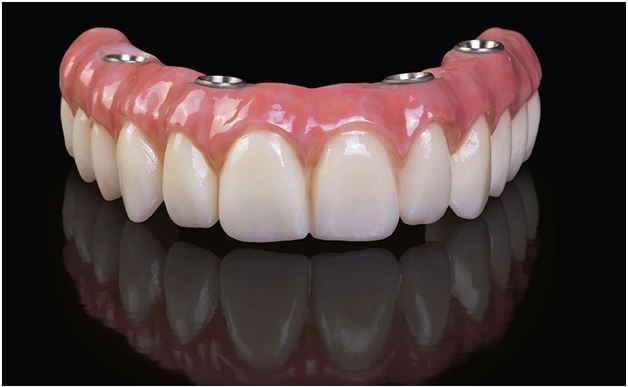You may lose one or more teeth due to decay, accident, or intentional extraction. A common solution is the use of dentures because of their removable nature. However, you can opt for a more permanent solution, known as dental implants.
Most seniors do not subscribe to dental implants because they involve a surgical procedure. But these days, dentists combine dentures with implants to provide a long-lasting solution to missing or decaying teeth.

Table of Contents
What Are Dental Implants?
Dental implants are structures that take the place of missing teeth. They are surgically fixed into a patient’s jawbone to support artificial teeth like crowns, dentures, or bridges. They consist of two parts: body and abutment. They may also include screws for fixing the abutment.
The surgeon inserts the implant body into the jawbone and then uses a screw to attach the abutment to the body. This extends through the gum to hold the artificial tooth firmly in the mouth. The artificial tooth is customized to match the color of the patient’s teeth. It also has a natural feel and fits nicely into the mouth, thereby, improving the appearance and function of the patient.
Dental implants could be subperiosteal or endosteal. Subperiosteal implants are affixed to the top portion of the jawbone. They are suitable for people whose jawbones do not have enough height, perhaps due to deterioration. Endosteal, on the other hand, is embedded within the jawbone and can contain more than one artificial tooth.

Although dental implants are not suitable for everyone, your dentist will ascertain whether your bones are healthy enough to undergo the procedure. The advantages of dental implants include the following:
- High rate of success
- Improvement in the patient’s chewing ability
- A more comfortable and natural feel in the mouth
- Reduces the risk of cavities in other teeth
- Reduces teeth sensitivity
- Doesn’t require removal at night
What Are Dentures?

Dentures are fake teeth made from metal, acrylic, or nylon. They are removable and help to reduce problems caused by missing teeth. Missing teeth create gaps in the mouth, making it difficult for patients to talk or eat.
Sometimes, teeth on both sides of the gap may tilt towards the space, resulting in crooked teeth. Depending on the situation, the dentist will remove and replace all the teeth. There are majorly two types: complete and partial dentures.
Complete dentures are suitable for people who require complete replacement for the lower or upper teeth. They are placed at the top of the gum between 8 to 12 weeks after the last tooth extraction.
Partial dentures are used when the patient loses some teeth. For instance, if some molars are missing in the lower and upper jaw, chewing would be a herculean task. Therefore, the patient requires something to fill in the space.
A partial denture consists of a metal framework and a plastic base. It is comfortable and can be taken off at any time. It also ensures that the unaffected teeth do not move or shift. You can visit https://www.webmd.com/ to compare complete and partial dentures.
How Do Dental Implants Work with Dentures?

When patients want to replace a missing tooth, they resort to dental implants because of their benefits. Although dentures are more economical, they make talking and eating difficult. They also require dental adhesives and could make the mouth feel sore.
Thankfully, dentists now have a combined option that helps patients enjoy the taste of two worlds. Here, the surgeon attaches 4 to 6 implants into the jawbone of the patient. It takes between 3 to 6 months for the screws to fuse properly into the jawbone. Afterward, the dentist attaches some dentures to the firmly fixed implants.
The dentist can combine the denture with an implant in two ways. A fixed combination is referred to as an implant-supported denture while a removable one is called an implant-retained denture.
Removable vs Fixed Implant Dentures
Here are some key differences between the removable and fixed implant dentures:
- Patients can easily take off the removable implant denture at night or when they want to clean them. However, a fixed implant denture is permanent and requires a different method of cleaning. Also, only a dentist can remove it.
- A removable implant denture is cost-effective compared to a fixed one. The latter requires more attachment bars to support the implants.
- A removable implant denture may slip out of the mouth but a fixed one is more secure.
Benefits of an Implant Denture
Here are some benefits of an implant denture:
Stability and Comfort
When both dental solutions are combined, the dentist secures the denture with 2 or more dental implants. This offers more stability and comfort than a conventional denture. As a result, the fake tooth won’t accidentally slip out while speaking or eating.
Improved Functionality and Self-Confidence
An implant denture improves the functionality of patients by allowing them to bite as well as chew food normally. It also enhances the facial appearance of patients, thereby, restoring their smile and self-esteem. The combination has a high success rate and can last for a longer period.
Reduced Bone Loss
The structure of the jawbone will shrink over time with dentures because they do not have roots and cannot determine how the jaw bites on food. Also, continuous use of an ill-fitted denture will lead to more bone loss, which means the patient must replace or realign the denture periodically.
But when a denture is combined with implants, the fusion provides a simulation that facilitates bone growth. It also increases bite pressure that mimics the natural teeth. Without this simulation, the jawbone will degenerate. You may want to watch this video to learn more advantages of implant-supported dentures.
The Bottom Line
It is possible to combine a denture with implants. The procedure is more economical than getting implants for more than one tooth. However, not every patient qualifies for this combination.
The patient must have healthy bone tissues. Otherwise, the procedure would involve bone grafting. Since an implant denture involves surgery, the healing time may be prolonged for diabetic patients. Therefore, it is important to seek recommendations from your dentist before forging ahead.




